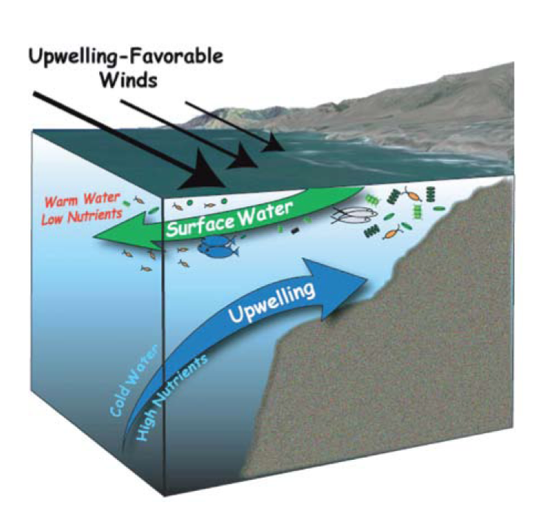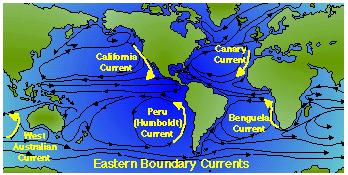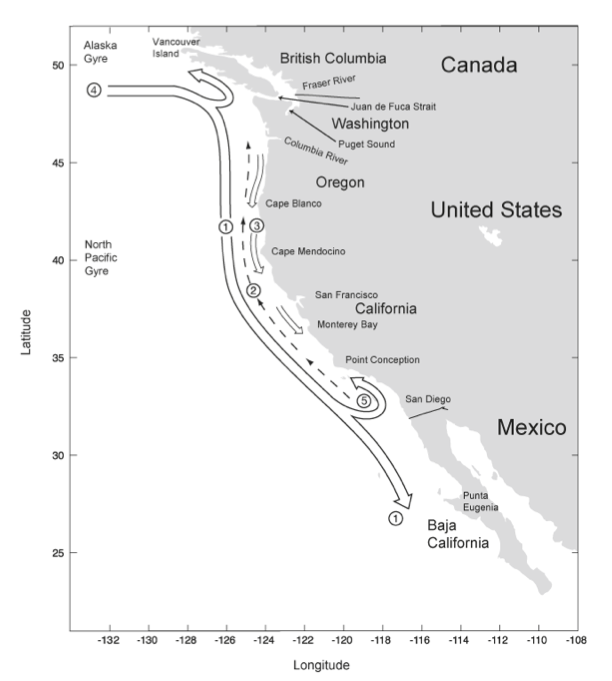Table of Contents
EBUS
Author: Nora Gallarotti
Definition
Eastern Boundary Upwelling Systems (EBUS) are characterized by a high productivity of plankton associated with large commercial fisheries, thus playing key biological and socio-economical roles. The western margins of continents are typically affected by upwelling of cold nutrient and DIC rich waters to the surface.
Upwelling Systems
 The western margins of continents are typically affected by upwelling favorable winds that bring subsurface waters to the surface. The equator-ward winds blow parallel to the shore and induce Ekman transportation of surface waters off-shore. As a consequence, surface waters are pumped up to the surface in coastal areas. The annual onset of persistent upwelling conditions occurs abruptly in late spring in an event called spring transition. The equator-ward winds predominate in summer because of east-west pressure gradients that evolve once the North Pacific High strengthens and the Continental Low deepens. These subsurface waters are cold, nutrient and DIC-rich. The high nutrient content increases the productivity and triggers phytoplankton blooms in the upper waters while the upwelled DIC causes a naturally low pH and Aragonite saturation state in the costal areas. Therefore the Upwelling Systems are hot spots of ocean acidification and at focus of various scientific studies.
The western margins of continents are typically affected by upwelling favorable winds that bring subsurface waters to the surface. The equator-ward winds blow parallel to the shore and induce Ekman transportation of surface waters off-shore. As a consequence, surface waters are pumped up to the surface in coastal areas. The annual onset of persistent upwelling conditions occurs abruptly in late spring in an event called spring transition. The equator-ward winds predominate in summer because of east-west pressure gradients that evolve once the North Pacific High strengthens and the Continental Low deepens. These subsurface waters are cold, nutrient and DIC-rich. The high nutrient content increases the productivity and triggers phytoplankton blooms in the upper waters while the upwelled DIC causes a naturally low pH and Aragonite saturation state in the costal areas. Therefore the Upwelling Systems are hot spots of ocean acidification and at focus of various scientific studies.
The four EBUS
 Along with the Benguela, Canary and Humboldt Current Systems, the California Current System (CCS) is one of the four major Eastern Boundary Upwelling Systems. These systems are located on the eastern edge of the large subtropical gyres that dominate large scale ocean circulation in the mid-latitudes. These circulation patterns support cold, nutrient and DIC rich surface waters. Therefore EBUS belong to the most productive marine ecosystems worldwide. These upwelling areas contribute about 2-5% to the global marine primary production and 17% to global fish catch, while occupying less than 1% of global ocean area. Due to the upwelling of cold nutrient and DIC-rich water masses, EBUS are naturally more acidic than most of the rest of the surface ocean. This makes them sensitive to ocean acidification and to areas with a high potential vulnerability of marine organisms.
Along with the Benguela, Canary and Humboldt Current Systems, the California Current System (CCS) is one of the four major Eastern Boundary Upwelling Systems. These systems are located on the eastern edge of the large subtropical gyres that dominate large scale ocean circulation in the mid-latitudes. These circulation patterns support cold, nutrient and DIC rich surface waters. Therefore EBUS belong to the most productive marine ecosystems worldwide. These upwelling areas contribute about 2-5% to the global marine primary production and 17% to global fish catch, while occupying less than 1% of global ocean area. Due to the upwelling of cold nutrient and DIC-rich water masses, EBUS are naturally more acidic than most of the rest of the surface ocean. This makes them sensitive to ocean acidification and to areas with a high potential vulnerability of marine organisms.
CCS
 The California Current System (CCS) is one of the four major EBUS and covers a wide area along the west coast of North America. The current flows along the continental slope towards the north and is about 10-40 km wide. The region is affected by several principal circulation features such as the California Current, the California Undercurrent, the seasonal Davidson Current, the Southern California Eddy, the Coastal Jet and wind-driven upwelling. Although the CCS is the least productive of the four major upwelling systems, summer-time upwelling of nutrient enriched waters triggers high primary production, which in turn provides the basis for a rich coastal ecosystem across all trophic levels.
The California Current System (CCS) is one of the four major EBUS and covers a wide area along the west coast of North America. The current flows along the continental slope towards the north and is about 10-40 km wide. The region is affected by several principal circulation features such as the California Current, the California Undercurrent, the seasonal Davidson Current, the Southern California Eddy, the Coastal Jet and wind-driven upwelling. Although the CCS is the least productive of the four major upwelling systems, summer-time upwelling of nutrient enriched waters triggers high primary production, which in turn provides the basis for a rich coastal ecosystem across all trophic levels.
Reference
- Hauri C.(2014). Modeling ocean acification in the California Current System. Diss. ETH No.20238.
- Kudela R.et al. (2008). New insights into the controls and mechanisms of plankton productivity in coastal upwelling waters of the northern California Current System. Oceanography, 21(4):46-59.
- Daneri G. et al. (2000). Primary production and community respiration in the Humboldt Current System off Chile and associated oceanic current System off Chile and associated oceanic areas. Marine Ecology Progress Series, 197:41-49.
- Pauli D. and Christensen V. (1995). Primary production required to sustain global fisheries. Nature, 302:295-301.
Tasks
Write a short summary of each of the EBUS regions.